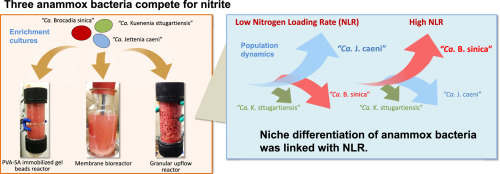当前位置:
X-MOL 学术
›
Water Res.
›
论文详情
Our official English website, www.x-mol.net, welcomes your feedback! (Note: you will need to create a separate account there.)
Microbial competition among anammox bacteria in nitrite-limited bioreactors
Water Research ( IF 12.8 ) Pub Date : 2017-08-26 , DOI: 10.1016/j.watres.2017.08.052 Lei Zhang , Yuko Narita , Lin Gao , Muhammad Ali , Mamoru Oshiki , Satoshi Ishii , Satoshi Okabe
Water Research ( IF 12.8 ) Pub Date : 2017-08-26 , DOI: 10.1016/j.watres.2017.08.052 Lei Zhang , Yuko Narita , Lin Gao , Muhammad Ali , Mamoru Oshiki , Satoshi Ishii , Satoshi Okabe

|
Phylogenetically diverse anammox bacteria have been detected in most of anoxic natural and engineered ecosystems and thus regarded as key players in the global nitrogen cycle. However, ecological niche differentiation of anammox bacteria remains unresolved despite its ecological and practical importance. In this study, the microbial competitions for a common substrate (nitrite) among three anammox species (i.e. “Candidatus Brocadia sinica”, “Candidatus Jettenia caeni” and “Candidatus Kuenenia stuttgartiensis”) were systematically investigated in nitrite-limited gel-immobilized column reactors (GICR) and membrane bioreactors (MBRs) under different nitrogen loading rates (NLRs). 16 S rRNA gene-based population dynamics revealed that “Ca. J. caeni” could proliferate only at low NLRs, whereas “Ca. B. sinica” outcompeted other two species at higher NLRs in both types of reactors. Furthermore, FISH analysis revealed that “Ca. J. caeni” was mainly present as spherical microclusters at the inner part (low NO2− environment), whereas “Ca. B. sinica” was present throughout the gel beads and granules. This spatial distribution supports the outcomes of the competition experiments. However, the successful competition of “Ca. J. caeni” at low NLR could not be explained with the Monod model probably due to inaccuracy of kinetic parameters such as half saturation constant (Ks) for nitrite and a difference in the maintenance rate (m). In addition, the growth of “Ca. K. stuttgartiensis” could not be observed in any experimental conditions, suggesting possible unknown factor(s) is missing. Taken together, NLR was one of factors determining ecological niche differentiation of “Ca. B. sinica” and “Ca. J. caeni”.
中文翻译:

亚硝酸盐限制的生物反应器中厌氧氨氧化细菌之间的微生物竞争
在大多数缺氧的自然和工程生态系统中都发现了系统发育多样的厌氧细菌,因此被认为是全球氮循环的关键参与者。然而,尽管厌氧菌具有生态和现实意义,但其生态位分化尚未得到解决。在这项研究中,系统地研究了在亚硝酸盐受限的凝胶固定柱反应器中三种厌氧菌物种(即“ Candidatus Brocadia sinica”,“ Candidatus Jettenia caeni”和“ Candidatus Kuenenia stuttgartiensis”)中常见底物(亚硝酸盐)的微生物竞争。(GICR)和膜生物反应器(MBR)在不同的氮负荷率(NLR)下。基于16 S rRNA基因的种群动态显示,“钙。J. caeni”只能在低NLRS增殖,而“钙。在这两种类型的反应堆中,B。sinica”在较高的NLR时都胜过其他两个物种。此外,FISH分析表明,“钙。J. caeni”主要是存在于内部分球形微聚合(低NO 2 -环境),而“钙。整个凝胶珠和颗粒中都存在“ B. sinica”。这种空间分布支持比赛实验的结果。然而,“ Ca。 ”的成功竞争。在低NLR下的“ J. caeni”无法用Monod模型进行解释,这可能是由于动力学参数(例如半饱和常数(K s)表示亚硝酸盐和维持率的差异(m)。此外,“ Ca ”的增长。在任何实验条件下均未观察到斯图加特犬(K. stuttgartiensis),这表明可能缺少未知因素。总之,NLR是决定“ Ca ”生态位分化的因素之一。B.报”和“钙。J. caeni”。
更新日期:2017-08-28
中文翻译:

亚硝酸盐限制的生物反应器中厌氧氨氧化细菌之间的微生物竞争
在大多数缺氧的自然和工程生态系统中都发现了系统发育多样的厌氧细菌,因此被认为是全球氮循环的关键参与者。然而,尽管厌氧菌具有生态和现实意义,但其生态位分化尚未得到解决。在这项研究中,系统地研究了在亚硝酸盐受限的凝胶固定柱反应器中三种厌氧菌物种(即“ Candidatus Brocadia sinica”,“ Candidatus Jettenia caeni”和“ Candidatus Kuenenia stuttgartiensis”)中常见底物(亚硝酸盐)的微生物竞争。(GICR)和膜生物反应器(MBR)在不同的氮负荷率(NLR)下。基于16 S rRNA基因的种群动态显示,“钙。J. caeni”只能在低NLRS增殖,而“钙。在这两种类型的反应堆中,B。sinica”在较高的NLR时都胜过其他两个物种。此外,FISH分析表明,“钙。J. caeni”主要是存在于内部分球形微聚合(低NO 2 -环境),而“钙。整个凝胶珠和颗粒中都存在“ B. sinica”。这种空间分布支持比赛实验的结果。然而,“ Ca。 ”的成功竞争。在低NLR下的“ J. caeni”无法用Monod模型进行解释,这可能是由于动力学参数(例如半饱和常数(K s)表示亚硝酸盐和维持率的差异(m)。此外,“ Ca ”的增长。在任何实验条件下均未观察到斯图加特犬(K. stuttgartiensis),这表明可能缺少未知因素。总之,NLR是决定“ Ca ”生态位分化的因素之一。B.报”和“钙。J. caeni”。



























 京公网安备 11010802027423号
京公网安备 11010802027423号